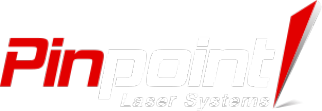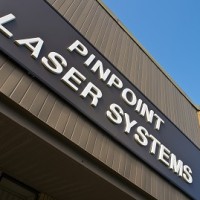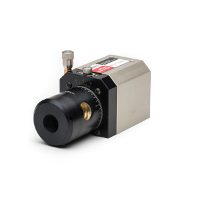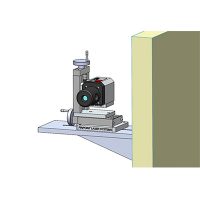John Maher: Hi. This is John Maher and I’m here with Mory Creighton, President of Pinpoint Laser Systems in Peabody, Massachusetts. Good morning, Mory.
Mory Creighton: Good morning, John.
John: So before we start why don’t you tell me a little bit about Pinpoint Laser Systems?
Mory: Sure. Pinpoint Laser Systems was started in 1992. For a number of years prior to starting Pinpoint, I had worked for a laser company building systems for the federal government and other companies. I had always wanted to start a company and during this time, I thought it would be interesting to start a company that produced products that could be used by industry to make their manufacturing more efficient. I started the company in the basement, attic, and garage of my home. It didn’t take long to outgrow that space so we moved to a facility in Newburyport, Massachusetts, which is north of Boston. We were there for 15 years or so and then eventually outgrew that space as well. We are now in Peabody, Massachusetts, and in our full production facility where we build a variety of laser products and we ship these products all over the world. Also, if a company requests it, we can build custom mounts and fixtures to accommodate their applications. It has been a very interesting company growth history. We have wonderful employees on board, great products, and I think we all enjoy the work that we do.
John: How many employees now?
Mory: We buy many of our components and have custom parts made by local shops so we have been able to keep the company small, we are under 20 people . Here in Massachusetts, we have machine shops, circuit board houses, and others all around us and so we farm out a lot of the work to people that can make and supply the parts that we need, better and faster than we can. Here at Pinpoint Laser Systems, we do all the final assembly, the design of these products, the finished alignment, the programming, and all of that. It’s worked out really well over the years.
John: Good. Maybe you can start off by telling me a little bit about why alignment is important in today’s industry?
Mory: We’ve seen over the last probably 50 years as production becomes more capital intensive that essentially there are fewer people involved in the production of goods and items here in the United States and all over the world. Manufacturing is relying a lot more on capital equipment. As such, keeping this equipment running efficiently and preventing breakdowns is an important part of being a good manufacturer. Laser alignment is helping manufacturers keep their machinery running better, faster, and more efficiently.
John: OK. Tell me a little bit more about machinery alignment and what that is.
Mory: Machinery alignment varies from company to company and what people are doing with their production processes, but essentially geometric alignment on manufacturing equipment checks and ensures the correct movement of machinery and parts. Either the product is moving through the machine or there’s something in a production process that’s moving to the product to make it. It could be something as simple as a conveyor belt carrying product through hot ovens in food processing or it could be a piece of metal that’s being moved through a machine that’s drilling and boring holes in it. Alignment could also be, for example, putting wings on an airplane or a propeller shaft into a ship. Simply stated, alignment is the positioning of moving elements in a production process. We tend to group these out into a couple of areas. For example, straightness considers machinery that is running straight or linearly back and forth like a milling machine or a saw. Lasers and alignment devices can be used to make sure that this straightness and linearity is maintained through the process. Flatness is a key part of assembling and producing many products and laser alignment is a good way to check the flatness of products and the machinery that makes them. Squareness or what we call perpendicularity is the forming of right angles between things. Again, for machining parts and having a process where something comes down that’s square to another process is very important for another product. Parallelism is a key area for a laser alignment. If you think of a paper mill there is a long machine that is forming and carrying paper from the beginning to the end across a bunch of rollers, and those rollers all need to be aligned so that the paper doesn’t stretch or tear. Within the paper industry, this is an important part of paper making because in a typical paper machine those machines may be about 30 feet wide and the paper is rolling through the machine at close to 75 miles an hour. When something goes wrong with alignment, you have a lot of paper flying in a lot of directions and it’s not being taken up on the role at the end. Similarly for plastics, lasers and alignment are used a lot for lining up rollers so that they produce the product consistently over time and don’t jam up or bind. Another area we work with customers on is what we call bore and shaft alignment. For example, a ship with a propeller shaft is a key alignment application for laser alignment and the mechanical alignment to line up the engines, the shafts, and the propulsion systems in ships and airplanes and other powered vehicles. So alignment touches manufacturing in a lot of different ways. It depends on the industry and what they’re making.
John: So it sounds like there’s a lot of different industries you work with and a lot of different applications where alignment comes into play but is alignment really right for everybody?
Mory: That’s a good question. I think years and years ago we looked at this saying, well every factory, every smokestack is a potential customer and in reality that’s not the case. Industrial alignment is really, really important for a lot of manufacturing but it’s not used in the places that are most obvious. For example, there’s food production. A piece of food, breakfast food, cereal, pet food, things like that you don’t think of as being carefully aligned or manufactured and yet the machinery that’s used to make that product that we all enjoy has very, very tight tolerances in its process. So those are customers that tend to require a lot of laser alignment. Then of course there are manufacturers making electronic semiconductor chips, plastic parts, metal components and other things that are very dependent upon alignment. The machinery that’s used in many production facilities has tremendous forces on it and a lot of heat and you get wearing components. So over time, keeping that machinery aligned well will make it last longer, produce better product, and ultimately improves the quality of product and the profits for the manufacturing company.
John: So is machinery alignment really worth it in terms of the cost that a manufacturing company would put into it and the time involved in it?
Mory: Once again it really depends on the nature of the organization but we find that many of our customers and people that get involved in laser alignment or even regular mechanical alignment see a return on investment very quickly. For example, if you consider a factory line that is producing perhaps $5,000,000 worth of product a year given the working hours in a year that’s about $2,500 an hour and if that machine is down for a day that adds up to about $20,000 a day. If the company is waiting around for somebody to come and fix that production line or something unexpected occurs for a week that’s $100,000 of downtime on that machine plus the employees who are there but not producing product. If you can catch that production problem before it occurs, if you can anticipate that problem through laser alignment or through mechanical alignment then you can save a lot of time, a lot of headaches with customers, and ultimately produce better product. We frequently make the comparison to your car. We all put gas in our car. We all change the oil. We presumably all bring our cars to garages to have them aligned and checked. When we forget to take care of these basic automobile needs that car can leave us stranded. When you’re trying to pick up your kids at school or trying get to an important meeting, you don’t have the time for your car do decided to breakdown on you – much like downtime in a manufacturing operation. We see the same thing happening in manufacturing and alignment is just an important part of that equipment maintenance and care process.
John: Right. I can see where that would be, like you said, an important part of manufacturing and making sure that everything runs smoothly. Is it easy to do a machinery alignment or is this something that’s really difficult to implement?
Mory: Once again, it depends on the application involved. If you run a plastics production line with a number of rollers and plastic film are coming out of a machine and being rolled up to make trash bags or similar film products, that machine can very easily be aligned with a laser system.. If you’re working in a paper mill with a machine that’s 800 feet long and might be 3 stories high, then this alignment is more involved. In general, the alignment it depends on what the application is. One of the things that has developed in the last 20 years is the advent of lasers and electronic circuitry. The developments at Pinpoint Laser Systems have helped replace old methods with products and techniques that are faster, more precise, and easier to use. Years ago, people would stretch piano wire, fishing cord, and string between machines and they’d have their chief maintenance person with a ruler and a good set of eyeglasses staring at the ruler trying to align that machine to a piece of wire or string. We’ve essentially replaced the string and the wire with a laser beam. We’ve replaced that poor employee’s eyes with a very accurate receiver that delivers measurement readings on a digital display and that display can then be connected into a computer to save results on what’s happening with that machine for monitoring the health of that machine over time. So new technology has really made alignment of machinery a lot easier to do.
John: OK. Say if I had a manufacturing company and I came to you and said our guys are really good mechanics but they don’t’ really know much about lasers. It might be kind of complicated, are they going to be able to figure this out?
Mory: Excellent question. We talk with hundreds of companies every year with all sorts of different employee capabilities and machinery with different complexities and it really is a balance. One thing that we see happening over and over again — is that the manufacturing employees that work with these machines have a lot of inherent knowledge as to how their machines work. They may not be able to express this knowledge in scientific terms but they have very good instincts as to how that machine works and when that machine is having problems — they can sense it. Laser alignment and mechanical alignment is essentially another set of tools, which put into the hands of those employees, allow them to better diagnose and understand, with quantitative data, what’s going on with that machine and communicate these findings. This helps in preventing unexpected breakdowns and developing a better plan for machinery maintenance and repair. It’s really like handing them a better ruler or a better device that they can use to diagnose what’s happening with their machine. What we find over time is that employees who work with machinery and understand the production process gravitate quickly to these alignment products and it helps them out a lot.
John: So how often does machinery alignment need to be done? Is it a weekly basis, a monthly basis, or what?
Mory: It depends on the manufacturing application. We have some customers who literally align their equipment or check the alignment of their equipment for preventative maintenance every single shift, between shifts, even on an hourly basis in some cases. We have other customers who will wait and maybe check their lines at week’s end or sometimes they might have quarterly shutdown intervals so they wait until then. We also have many customers that just keep their alignment systems in its case in the maintenance area or with a plant engineer in case a machine goes down. If this should happen they bring out their laser alignment system to diagnose the problem and get their line back up and running quickly. So it covers a range of applications.
John: OK. Good. So today I’ve been talking to Mory Creighton of Pinpoint Laser Systems. Mory, thanks very much.
Mory: Sure. It’s been interesting.
John: Look for our next podcast when we’ll be talking about laser alignment contractors versus doing it yourself.





